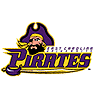
East Carolina Pirates
|
East Carolina Pirates Football History |
|||||||||
|
Pee Dee
The Pirate became associated with East Carolina
University in 1983. There was a contest to name the Pirate, where the
elementary schools of Pitt County were involved and from the nickname
Pee Dee the Pirate was derived. The name Pee Dee was believed to come
from the Pee Dee Rivers that flow through North and South Carolina.
Pete
Pete, by the way, is another story. Pete was an
unofficial dog mascot, but only for a few years in the mid-1970s. Pete
resembled the dog in the "Little Rascals" movies and carried the
reputation of a back-alley brawler with an intense dislike for rams (the
mascot at the University of North Carolina at Chapel Hill) and wolves
(the mascot at NC State University). During Pete's time, the defensive
players on the Pirate's football team were called the "wild dogs"
because the players performed like a vicious pack of them.
Other mascots have included students dressed as parrots and pirates. A
live wildcat was the mascot in 1930 - 31.
East Carolina University adopted Pirates as an athletic
namesake because the school is located near the North Carolina coast
where pirates often harbored their ships. Edward Teach, known as "Blackbeard,"
had property in Bath and on Ocracoke Island. The remains of one of
Blackbeard's ships, the Queen Anne's Revenge, was recently found near
Beaufort, N.C.
|
|||||||||
 Back
in the colonial days there were pirates that stayed up and down the
rivers. In December of 1985, the Chancellor of ECU decided to drop the
nickname Pee Dee from the mascot's name, and to only be called the
Pirate. This was a result from ECU's student body who said that it was
unfair because they did not have any say in naming the mascot. Over the
years, people still refer to the mascot as Pee Dee "The Pirate".
Back
in the colonial days there were pirates that stayed up and down the
rivers. In December of 1985, the Chancellor of ECU decided to drop the
nickname Pee Dee from the mascot's name, and to only be called the
Pirate. This was a result from ECU's student body who said that it was
unfair because they did not have any say in naming the mascot. Over the
years, people still refer to the mascot as Pee Dee "The Pirate".